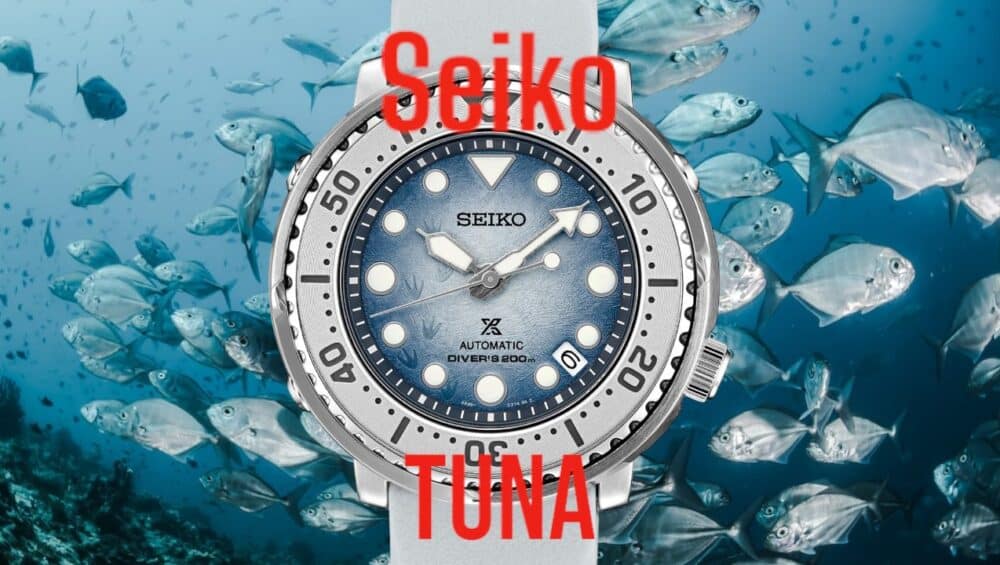Seiko Tuna 6159: And its Popular Variants
The most well-known timepieces in this range with nicknames are from the Seiko Tuna diver’s series.
The Seiko 62MAS was the first diver’s watch the company had made. Two years later, in 1967, their second diver was released, followed by a third in 1968. Up until a customer complaint came in their inbox in 1968, the first three Seiko divers were regarded as superb watches in those years. This complaint changed the course of Seiko diver watches forever.
A brief history of the diving scene at the time: recreational scuba diving grew in popularity in the late 1960s and early 1970s. Jacques-Yves Cousteau, a renowned ocean environmentalist and filmmaker, popularized scuba diving at the time. Scuba diving had previously only been practiced for military and marine research purposes. In two ways, Cousteou made a significant contribution to the development of recreational scuba diving. First, he co-invented the ‘aqualung’ in 1943, making dive equipment more accessible and cheaper for a larger variety of individuals. Second, as part of his efforts to save the oceans, he penned best-selling books and produced internationally renowned movies on the underwater world.
Positive Criticism
Regarding the creation of our Seiko Tuna Dive watch in 1968, a saturation diver from Kure City in the Hiroshima prefecture wrote to Seiko’s engineers. The letter included a thorough explanation of a problem with helium gas filtration that Seiko divers had, which had an impact on the crystals in a saturation condition.
Seiko Engineer Ikuo Tokunaga’s team was assembled by Seiko once they became aware of the reported issue. The same year, Tokunaga’s team set out on their mission, presenting brand-new concepts rather than making changes to the traditional Seiko diver’s form factor. The iconic Seiko Tuna and its several following modifications were the result of Seiko’s innovative methodology, which took more than seven years and 20 patents to develop.
While Rolex and Omega were already working on the Helium Gas Problem with Saturation Dives at the time, Seiko’s innovative approach was the one that solved the problem by creating something new. Seiko came up with an unmatched “Tuna Can” design, named due to its resemblance to a can of tuna. Since its introduction, admirers have cherished this Seiko diver watch with its distinctive “tuna case.”
The Reaping the Fruits of a Seven-Year Labor
The Seiko Tuna dive series’ remarkable characteristics are the product of several international “firsts” and more than 20 patents. As a result, a trustworthy, flawlessly constructed professional diver watch was produced that had no equal. The following are a few of the most notable “firsts” from the tuna:
- the titanium monobloc case (a one-piece case with no case back)
- the ceramic protective shroud
- the revolutionary L shaped gasket (lug-less)
- the vented strap and many more
The Origina Seiko Tuna
The original Seiko Tuna, sometimes known as the “Grandfather Tuna,” was introduced on the market in 1975 and was designed to endure the rigorous demands of professional diving. The outer case cylindrical protection was given the nickname “tuna can” because of its form, which was the most important aspect. Its hefty dimensions—its diameter, thickness, and the metallic watch bezel—remind one of a tuna can.
The absence of a case back was one of Seiko’s ground-breaking design innovations for the original Seiko Tuna watch and its variations. Only the front of this single-piece box could be opened, ensuring an airtight installation. This made it possible to address the helium problem by offering qualities like great shock resistance and immersion-proofing.
The outer case shield (“shroud”) that wraps around the side of the watch is another feature. This was a novel Seiko innovation that became the brand’s defining characteristic. The shroud shields the watch in the same manner as cans shield food inside.
The vented strap, which is also a very significant component of product design, is the final characteristic that ought to be mentioned. Engineers devised a wonderfully effective technique to attach this large gadget to the owner’s wrist. Just another illustration of the exceptional skills of Tokunaga’s engineers is this vented strap design.
The Seiko Tuna series has been regarded as a useful dive watch for its dependable service to expert divers ever since the Grandfather Seiko Tuna watch was introduced.
The fact that it was designed specifically for the professional diving market meant that its exorbitant cost had no bearing on the product’s rising notoriety.
More information on these accomplishments are provided in the following quote from Mr. Tokunaga:
“… using the special gasket of L type and one-piece case became the conclusive factor in the He-tightness. As the result of the experiment, the penetration of helium gas is suppressed by about 1/100 to the conventional watch case, the inner pressure of the case does not turn into high pressure and the diver’s watch of the ideal saturation diving specification, which does not need “helium gas escape valve” is completed.”
As an outcome of this effort, some of these Seiko Tuna diver characteristics have been considered industry standards since 1975.
Gold and Dark Tuna
The 7549A and 7C46 variants of the first watch in the series were released shortly after. They are both referred to as “Golden Tuna” because of the striking gold tint in their shrouds and other gold dial accents.
After its first debut, the Golden Seiko Tuna underwent a number of revisions, but the watch’s design and construction remained the same. By using the Reference SSBS018 model, Seiko revised the case back, bezel, vented strap, and dial.
The SBBN011 then arrived, which the fans have dubbed the Darth Seiko Tuna because of its extensive artistic makeover. It had a titanium nitride coating known as Diamond Like Coating, or DLC-coated titanium, which covered the golden accents with an all-black appearance.
The Star Wars watch had a different text and dial than its predecessors, but it had the same ceramic shroud and hex screws.
A limited-edition Golden Tuna model that Seiko released in 2018 was seen as an excellent marketing decision. It rose in value in the eyes of collectors because there were only 1,978 pieces ever produced. The limited-edition model became known as the Seiko 1978 Quartz Saturation Diver Recreation. A mouthful, for sure! The new rating of 1000m of water resistance, which is much deeper than most divers, was its main selling point.
The Historical Collection of Seiko Tuna SBDX005
Later in 2000, Seiko produced the ref as a complementary product to the Golden Tuna lineage. SBDX005 was created as an homage to the 1975-produced original mechanical model. In both form and soul, this Seiko SBDX005 Historical Collection recalls the classic ref 6159-7010, yet it is powered by the superior 8L35 movement. The dependable new movement has 26 jewels, a 28,800 vph heartbeat, and a 50-hour power reserve.
Seiko decided to only create 1,000 pieces of this model as a limited edition. Seiko increased the price value of the SBDX005 release for collectors even more than the original watch it is based on, which is unusual in the watch industry. The SBDX005 release is a limited edition with a new mechanical powered heart.
“Baby Tuna” Ref. 7549-7010 and 7C46-7011
The last Seiko Tuna series movement to be launched chronologically is the 5M23, and the watches it drove were affectionately referred to as “Baby Tunas” by Seiko enthusiasts. These are also known as the 300m Seiko Tunas. Since these variations are smaller, most people find them more comfortable to wear, hence the nickname Baby Tuna.
The ref.7549-7010, which was introduced in the late 1970s, was the first Seiko Baby Tuna to be seen. The Seiko Baby Tunas had curved hardlex crystals and the most noticeable alterations were to the lugs and case back.
These divers fell into a lesser category than their Seiko Tuna big brothers since they did not include the monobloc case. However, the adjustment made them less expensive and simpler to maintain. Later, Seiko updated the line with the ref 7C46-7011, which has since become a mainstay Seiko diver timepiece for the Tuna family since the early 2000s.
2021 Released Seiko Tuna Variant
The Seiko Prospex 1986 Quartz Diver’s 35th Anniversary was released to mark the 35th anniversary of the “Seiko Golden Tuna” 1000m watch. This version keeps the original watch’s distinctive titanium and ceramic shroud as well as its reliable quartz movement.
However, the updated dial color, a gradient of blue on the top half fading into black, is the key point of design uniqueness for this anniversary version. The design of the watch, intended to mimic the depths of the ocean, eliminates several golden features from the original, leaving just the clasp and screws holding the shroud in this anniversary version.
This release might be viewed as the pinnacle of the whole Seiko Tuna line. In terms of design and water resistance, it is the clear victor. This explains why it cost USD$2,600 when it was released. Although being on the high price side, was quite affordable compared to many other well-known dive watches. Additionally, there are various design elements in the Seiko Prospex 1986 Quartz Diver’s 35th Anniversary that enhance the overall appearance. The new blue-black dial and the yellow seconds hand complement each other nicely. The depth level of water resistance is listed at 1000 meters, however it may operate far further, as is the case with numerous Tuna versions.
Tuna Conversion Case
We have wonderful news for you if you love the Seiko Tuna and have always wanted to modify it. We now provide SKX007 to Tuna conversion cases. It resembles a Seiko Tuna but will work with the extensive selection of SKX007 mod parts that are readily accessible.
The lug-to-lug distance is 46.5mm, while the case’s diameter is 44mm. The strap has a 22mm width. The thickness measures 11.2mm. Overall, it is a little bit smaller than the grandfather Tuna, but in every other way, it is an excellent conversion of the original design.
The Tuna is not going anywhere!
This diver watch has consistently ranked among the top five dive watches of all time throughout the history of the Seiko Tuna series. However, the emotion this Seiko Tuna line inspires among aficionados is often sharply divided. They either adore it or detest it. One may find innumerable posts describing it as an unsightly watch by searching the internet. This may be the result of an incorrect understanding of the significance of particular characteristics of the designs.
Fans and users, on the other hand, highlight its thoughtful design. Even its distinctive vented strap helps it fit comfortably. You may choose to change certain particular design elements on your Seiko by using mod parts to build or change your watch however you desire.
One of the largest selections of Seiko mod parts can be found at Watch-Modz. We have a ton of aftermarket parts in stock for common Seiko SKX007 customizations.
Additionally, we are always developing new Seiko-inspired components, such as the Tuna SKX conversion case.
If you want to start modding your own, browse through our catalog, you won’t regret it!
About The Author

Pamela Tabago is an Information Specialist at Watch-Modz LLC. She is passionate about everything related to watches, from the best automatics to modding a Seiko.
She brings her data-driven experience in informative writing and her love for watches to the blog. She also provides watch-related content for other modding enthusiasts like herself.

